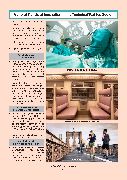General Trends of Innovation in the Technical Textiles Sector tion and mechanical stimuli re- sponses •integration of fully customizable self- lighting materials based on active fibers and yarns, and inte- gration or programmable textile matrixes for interactive sensing •light and resistant structure with PTFE membrane for architecture •separating tissues for growing veg- etables Key challenges in the sports sector • •development of light weight perfor- mance garments having new tex- tile surface coatings enhancing thermal management (insulation), controlled drug release for muscle care, and also proving optimized comfort, low pill, low shrink and fast dryingHealthcare and medical sector integration of low power/autono- mous bio-monitoring and/or integrat- ed ICT and loT communication sys- tems for training monitoring and per- formance assistance and integra- tion concepts of training analytics, always connected and data shar- ing for garment/textile structures “peripherals” Key challenges in the personal protection sector: • •the integration of geo tracking and personal GPS systems (Global Po- sitioning Systems), physiological and biometric monitoring, embed- ded and integrated communications and energy harvesting, with all data monitoring systems sharing data in real-timeAutomotive and aeronautics sector integration of cooling/heating sys- tems into garments Key challenges in building and living sector: •development of new functional tex- tile materials using nano materials and industrial waste, eco-friendly technologies (like ultrasonic depo- sition, bi/tri- component fibers, UV curing coatings), considering mul-sports sector NCM-OCTOBER 2021 52
